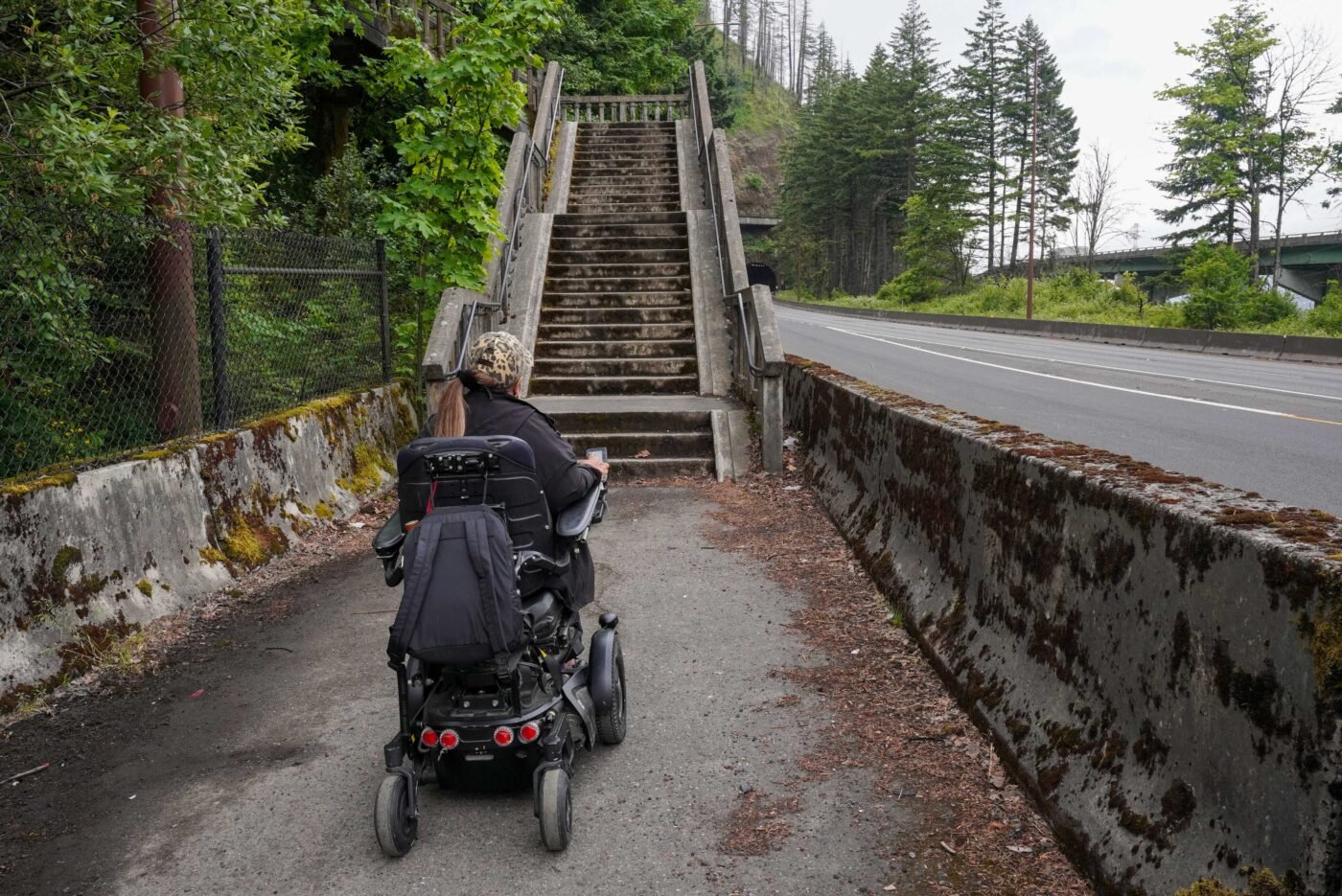
There are few tools left for advocates to create urgency around the need to replace a set of inaccessible stairs near the Eagle Creek Trailhead on the Historic Columbia River Highway State Trail. They’ve gotten the issue squarely on the radar of the Oregon Department of Transportation and they’ve filed lawsuits and staged protests.
Their latest effort? Tour the site with a nationally-known disability rights advocate and make sure a journalist is there to cover it.
Last Friday I drove to the Eagle Creek Trailhead about 40 miles east of Portland in the Gorge to meet former Ms. Wheelchair America and Board Member of the Rails to Trails Conservancy, Juliette Rizzo. Rizzo, 55, has progressive disabilities caused by a mosquito bite that led to an infection when she was three years old. Rizzo learned the ropes of accessibility advocacy while working as communications director for Judith Heumann, a woman many people consider the mother of the disability rights movement.
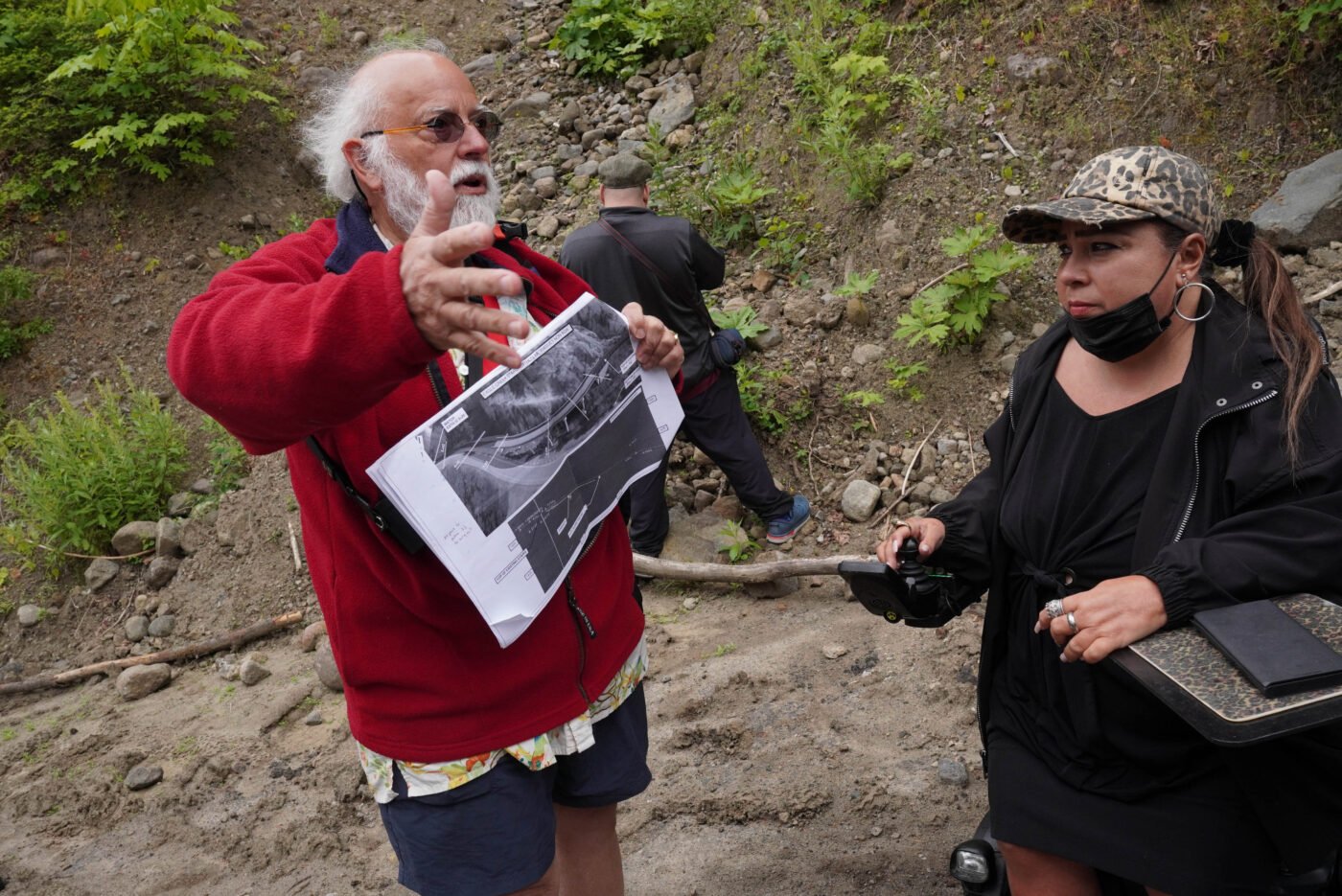
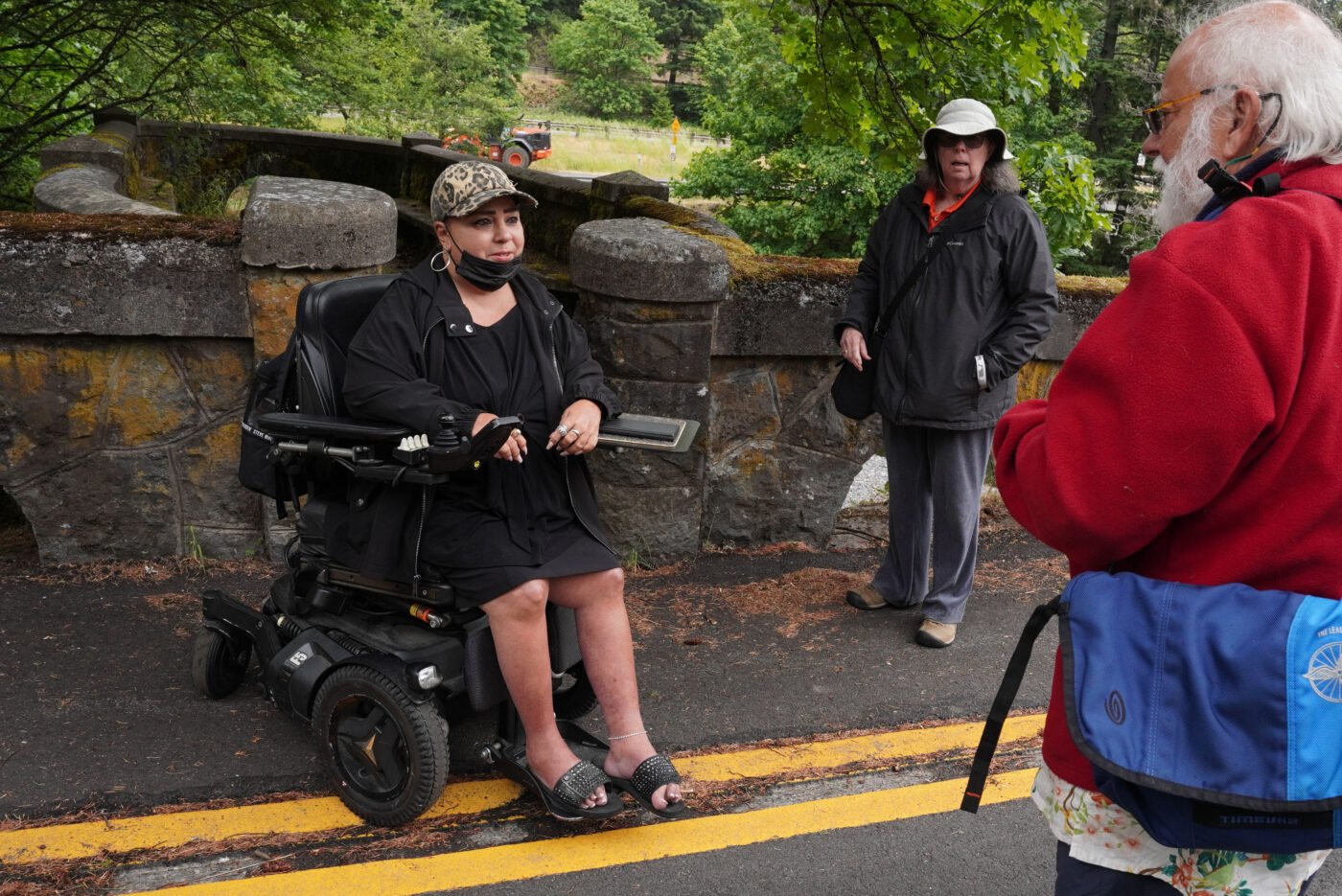
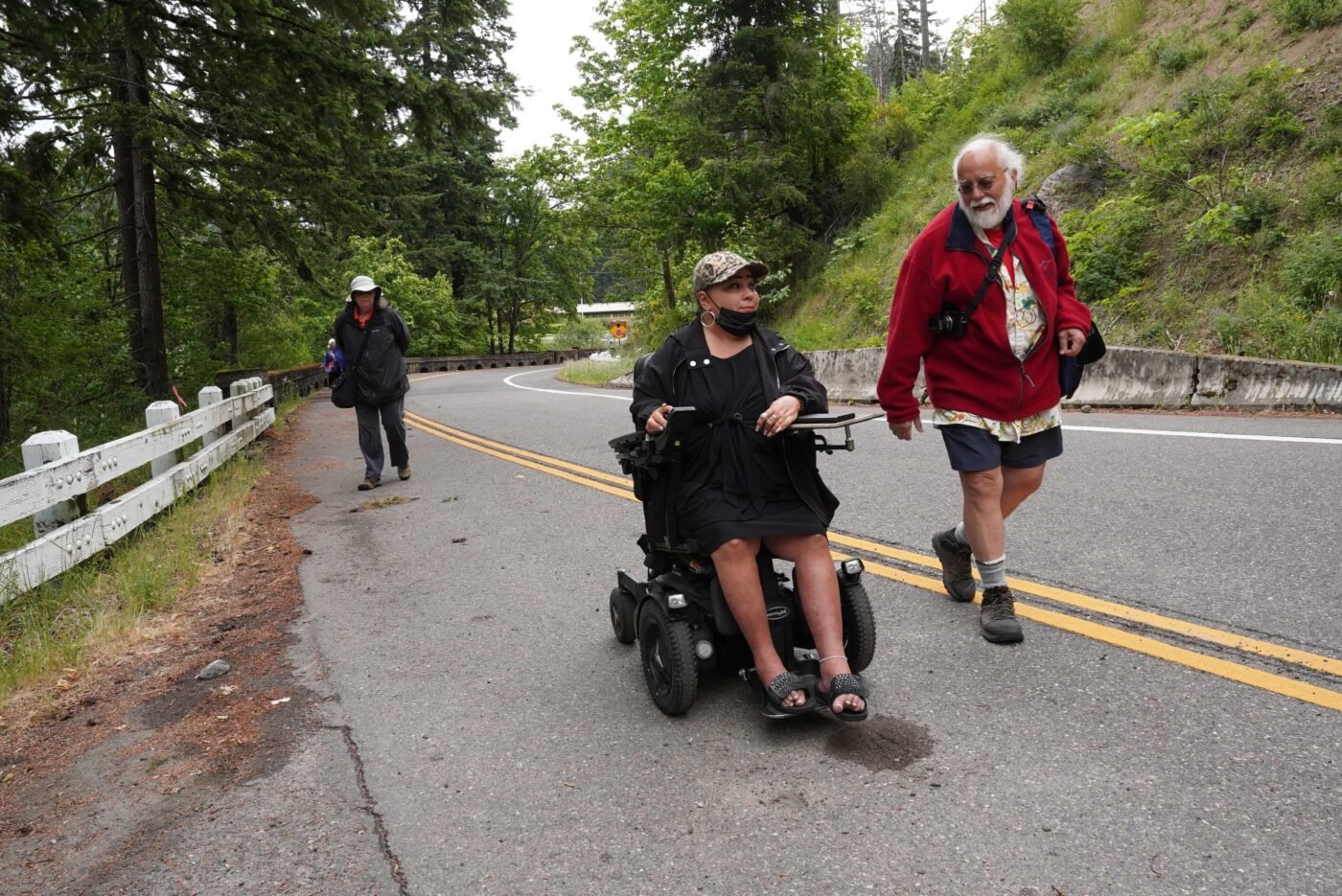
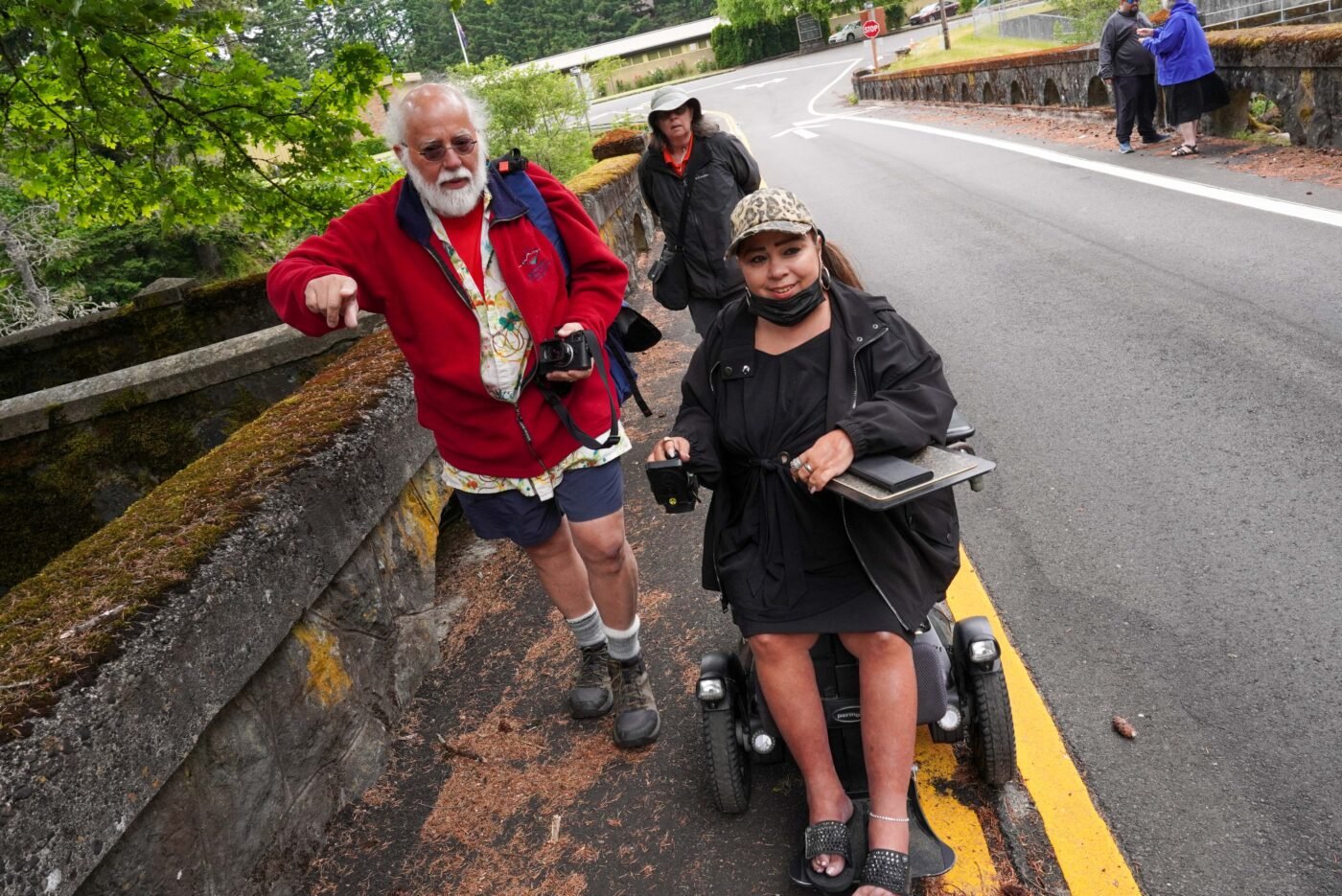
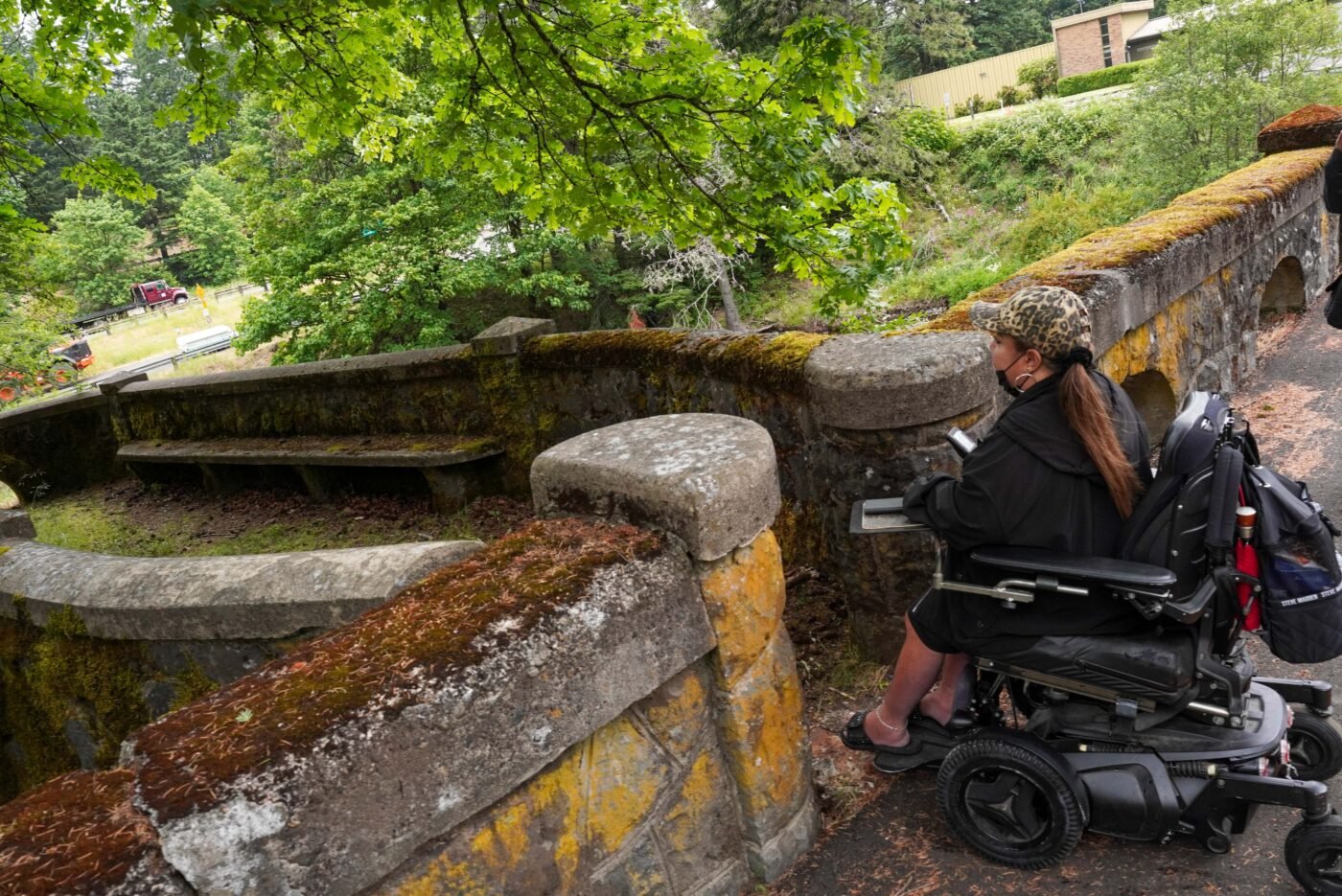
Rizzo was invited to the Gorge by AJ “Jerry” Zelada, a longtime Oregon cycling advocate who’s teamed up with Rizzo to broaden awareness of disability access issues to cycling and walking advocates (he’s also a board member of the Friends of the Historic Columbia River Highway and former chair the Oregon Bicycle and Pedestrian Advisory Committee). The duo has presented together at Walk Bike Places and the League of American Bicyclists National Bike Summit. Rizzo has also been a keynote speaker at America Walks and the 2018 Utah Department of Transportation Pedestrian Summit.
Now Zelada hopes Rizzo’s star power can help move the needle and finally replace this staircase once and for all.
Located about two miles west of Cascade Locks right off exit 41 and built in 1996 (six years after the Americans with Disabilities Act was passed), Zelada describes the stairs as a “tourniquet” that cuts off many people from enjoying the state trail. He thinks now is the right time to build an ADA-compliant ramp so that everyone can experience the state trail as ODOT creeps ever closer to fully connecting the 73-mile project between Troutdale and The Dalles. “The urgency is really the fact that the Mitchell Point tunnel is coming online in the second quarter of 2024,” he shared with me Friday. When the trail project is done, it will garner major headlines and attract thousands of tourists to Oregon to experience it.
But unless ODOT and their partners do something soon, the imposing and impassable staircase will still be there.
To Zelada, the issue goes beyond people who use wheelchairs and other mobility devices. He and Rizzo talk about “cross disabilities” — less visible conditions like cognitive, vision, sensory, hearing, and many other issues. Or even people who are older and/or recovering from injuries or medical treatments. Then there are the bike riders or people with strollers who simply cannot lift their bikes down the multiple flights of steep stairs. Imagine if you have a stroller with very small children and you have to make two trips, Zelada said. What happens to the kids while you set them down and make the second trip to get the stroller?
“A ‘cure’ for me is staying active, to lessen my rigidity and strengthen my immune system with fresh air… it’s also critical that I don’t run into barriers.”
– Juliette Rizzo
The Eagle Creek Trailhead, where we met on Friday, is one of the most ADA accessible parking lots in the Gorge. It’s relatively flat and has large parking spots for specially-equipped vans. It’s also one of the closest major trail access point to the Portland metro area.
As Rizzo and the rest of the group made their way to the stairs, we used the bike lanes between the parking lot and the trail. When we came upon an old lookout over the creek with a stone wall and bench in the middle, we realized its entry was too narrow for Rizzo’s chair. “So that was fun,” Rizzo said, sarcastically. “How awesome that would be and how easy that would be to make that accessible?”
For Rizzo, having experiences in nature are key to her health. “A ‘cure’ for me is staying active, to lessen my rigidity and strengthen my immune system with fresh air. It’s critical to me,” she told me. “And it’s also critical that I don’t run into barriers in the great outdoors.”
“There are many people that say, ‘Oh, well, she’s bound by a wheelchair.’ But what I say is, how can I be bound by the only thing that brings me freedom?”
But Rizzo wasn’t free to enjoy this trail. As we approached the staircase, she pointed out that there wasn’t even a sign from the parking lot saying that the trail was inaccessible to people in wheelchairs or with other physical disabilities. She then rolled right up to the base of the stairs, while others continued up them. Her friend walked all the way to the top to explore the forest where the path begins. With her head tilted up into the trees beyond the stairs, she said, “I just can’t join my friends.”
ODOT says they want people like Rizzo to be able to enjoy the full trail, but fixing the stairs just isn’t a top priority right now. ODOT’s Columbia River Gorge National Scenic Area Coordinator Terra Lingley shared in an email with BikePortland this morning that her office (working with the Oregon Trails Coalition) sent a “congressionally directed spending” (aka earmark) request to Congressman Earl Blumenauer’s office this earlier this year. “The package included a request for funding for alternatives analysis to understand the range of ADA-compliant solutions to address the Eagle Creek Stairs,” Lingley wrote. “These stairs remain on our priority list, but our first priority is to create the full connection of the [state trail].”
It’s a complicated project. The first issue is cost, which goes up every year. Then there are the technical and geological challenges.
In 2009 a project to replace the stairs with a ramp was estimated (very roughly) at $2.5 million. In spring 2022, an estimate from an engineering firm put the cost at $40 million (about the cost of the damage from the devastating 2017 Eagle Creek wildfire). Now Zelada says it’s up to $50 million.
“ODOT is out there, looking for money to do the project,” Zelada shared with me Friday as we walked back to the parking lot. “But they say in terms of an ADA priority, this is at the end of the line after many other projects and have given us a 2030 completion estimate.” ODOT has also said that they are prioritizing completion of the state trail before the stairway project.
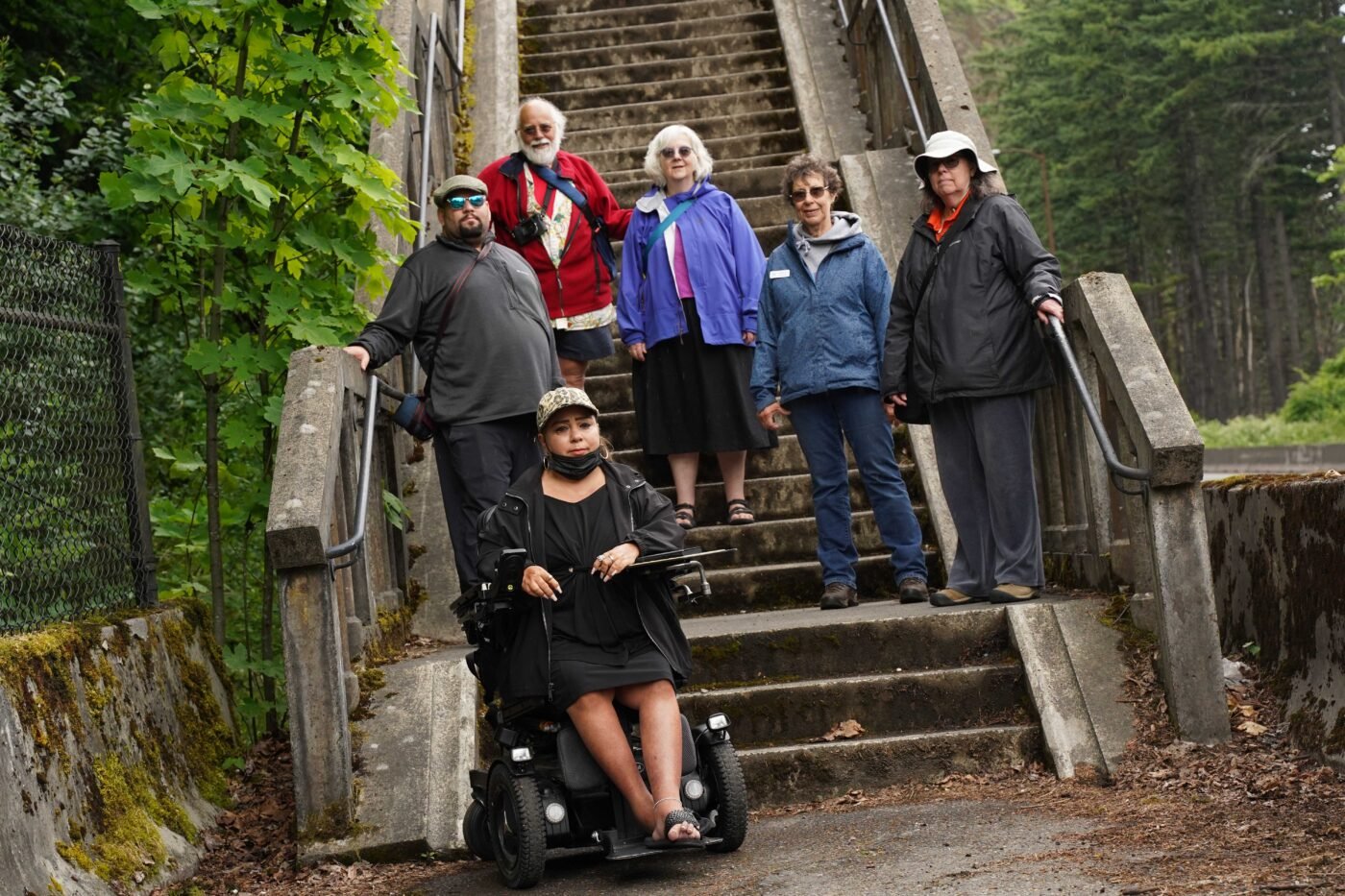
Costs aside, Zelada understands the complexity of building an ADA-compliant ramp on a steep slope is no small task — especially given the type of soils in the Gorge. “We’re under a riverbed right now,” he said, referring to the Missoula Floods that carved the Gorge thousands of years ago. “The earth out here is basalt with a sandy slope and is very unstable. You can’t fix a trail to it. The solution isn’t just getting rid of the staircase, it’s finding a solution within this living geology we are standing on.”
Despite the challenges, Rizzo seemed optimistic after her visit. “Many people think it’s about physical accessibility. But sometimes the most important things are accessible attitudes. With accessible attitudes, anything is possible,” she said. “It is just a matter of getting the right people at the right table at the right time to make this happen.”
Then in her typical wit, Rizzo added, “And you know, it would be easy to have me at your table because I bring my own chair.”
Here’s to hoping we can all roll on this trail with Rizzo when she returns to Eagle Creek in the coming years.


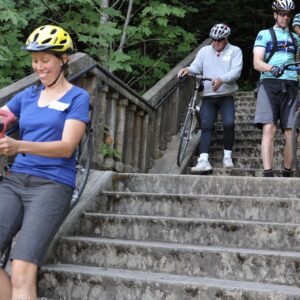
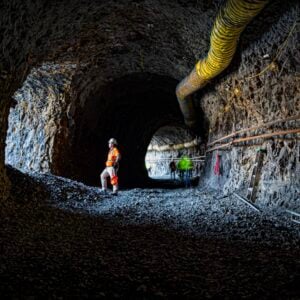
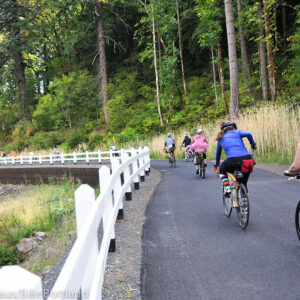
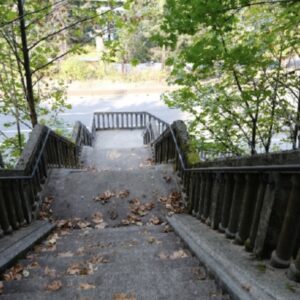
Thanks for reading.
BikePortland has served this community with independent community journalism since 2005. We rely on subscriptions from readers like you to survive. Your financial support is vital in keeping this valuable resource alive and well.
Please subscribe today to strengthen and expand our work.
The price we pay as a people is too high.
Amazing article shining a light on a serious problem that is apparently of little to no concern to the State.
How was this even possible?? It was illegal, morally and by code for six years before it was constructed. Does Oregon simply not care about its most vulnerable citizens and visitors, or is it just state governments in general who actively conspire to deprive citizens of access to places their taxes pay for? I am a little shocked that the estimates have shot up so and am curious if that is just more evidence of regulatory creep or contractor grift?
For the sake of context, can you please provide a ranked list of *most vulnerable citizens”?
As far as im concerned a ranked listing “of most vulnerable “begins and ends with people who physically need a machine to provide mobility. If your machine gets knocked over or stuck or you fall from it and cant get anywhere than thats pretty frickin’ vulnerable.
That can happen anywhere – not just a stairway.
You are correct. If one is reliant on a machine for ones mobility it can happen anywhere. What is your point??
I know, right! ODOT says they care because it sounds good. They know it’s illegal & they’re suppose to care.
Some example related food for thought, exception conditions:
Compliance is not practicable due to terrain. The phrase “not practicable” means not reasonably doable.
Compliance cannot be accomplished with the prevailing construction practices.
Compliance would fundamentally alter the function or purpose of the facility or the setting.
Compliance is limited or precluded by any of the following laws, or by decisions or opinions issued or agreements executed pursuant to any of the following laws:
https://www.access-board.gov/aba/guides/chapter-10-outdoor/
A bit farcical to imagine that any of those acts in question should qualify considering that this stairway hangs over a freeway exit. There is probably plenty of room in the shoulder of the exit to extend the ramp to allow for a shallow grade that would not require stairs – but that would require taking away marginal room from cars on a fairly cramped freeway exit.
It is beside, not over a freeway exit. There is no overhead clearance problem that “hangs over a freeway exit” would mean. It’s all to the right of the edge line and almost all off the pavement.
https://www.google.com/maps/@45.6394925,-121.9321072,3a,75y,60h,90t/data=!3m7!1e1!3m5!1sfwHedIpd_evF8JTRdcgqDQ!2e0!6shttps:%2F%2Fstreetviewpixels-pa.googleapis.com%2Fv1%2Fthumbnail%3Fpanoid%3DfwHedIpd_evF8JTRdcgqDQ%26cb_client%3Dmaps_sv.tactile.gps%26w%3D203%26h%3D100%26yaw%3D234.97293%26pitch%3D0%26thumbfov%3D100!7i16384!8i8192?entry=ttu
The terrain is challenging and so is the cost, could be proffered as reasons for delay, or not doing it as really desired in the first place. More is found in the older article here at this site as well as example imagery of a ramp. Me, I’d be fine with this or a longer ramp, given the length available to play with (get it under two per cent gradient if it is agreeable) but rather than as in the imagery I’d like something of stone with arches, even if faked with siding and fake arches, included. Kind of a miniature Semmering inclined viaduct, made to be more rustic in the sense of matching what’s along the old roadway, if viewed artfully…
https://bikeportland.org/2021/01/05/odot-will-seek-funding-to-replace-eagle-creek-stairs-on-gorge-path-324465
If money were no object, as activists like to assume, I’d like the Jersey barriers replaced with something more rustic and old-road looking, too.
Great news event!
I remember how dumfounded I was the first time I came across this barrier – without advance signage – with my loaded touring bike, as a spry rider in my 30s twenty years ago…even I struggled wheeling my rig down those stairs. I cannot say I came across anything similar on my West Coast or any worldwide bike tours since.
It’s always worth talking about how ODOT does have the money for a project like this – it just gets spent on other things instead. Like a new $62.5 million diverging diamond interchange in the valley. Seems to me like that money would probably be better spent on fixing orphan highways or getting ADA compliant.
Excellent point and completely agree! There’s always money and it demonstrates an organization’s leadership priorities as to what it gets spent on.
Like the saying goes, budgets are moral documents.
You can’t be serious.
32,000 vehicles pass through that interchange.
60 million improves safety for literally tens of thousands of people.
Blowing 50 million on a ramp is absurd, and we are more likely to end up with the stairs closed to EVERYONE for multiple years until funds become available sometime in the next decade.
Thanks so much.
There were 30 crashes at this exit from 2016 to 2020, of which 17 involved an injury of some sort. The next closest exit (Woodburn) also has 30 crashes, of which 20 involved an injury.
Most of the freeway interchanges in the valley have a crash rate roughly around this rate (data is here under safety), regardless of what type of exchange they are. This $62.5 million is being spent on something that is actually fairly unlikely to reduce crash rates in a significant way (here is a brief study on crash rates by interchange type). So in this case the money would be far better spent on one ramp in the Gorge, because it would be better spent on literally anything. Is this ramp the highest priority in the world? No, but it should be higher than a diverging diamond in the rural valley that primarily will serve a truck stop and exurban commuters.
Blowing $60 million+ on a project like this while scores of people die on the streets elsewhere is reprehensible. Diverging diamond interchanges are the pet favorite of traffic and highway engineers who think only about how many cars they can cram through a given piece of asphalt, and funding a project like this at the expense of countless others that are sorely needed elsewhere in the state demonstrates that perfectly.
Big talk talk from an anonymous commenter. “Blowing 50 million on a ramp” is absurd to you. ODOT has plenty of money. It’s just that they only care about using it to widen freeways
***Comment deleted because it’s completely off-topic and appears to be yet another attempt to grind the same axe you grind in nearly all your comments. Feel free to try again Randi J. – Jonathan***
No “ax to grind” Jonathan, just advocating for disabled people to have access to our paths of human powered transportation. Guess that’s not so important to you? Isn’t this article about the disabled and making sure they have appropriate infrastructure to transport themselves?
After all, it’s there in that country so many admire so superficially for said infrastructure. Plus don’t they want more humans separated from cars? It’s certainly better than what so many hate, mere paint, sharrows worse.
http://www.aviewfromthecyclepath.com/search/label/disabilities
Hey, great timing! I just did an out & back with a bunch of families and kids on the section from Eagle Creek to Cascade Locks on Saturday. It was beautiful, we stopped for ice cream at the Eastwind Drive-In, and then rode down to the Marine Park. The marine park has a playground, restrooms, water, and even a good beach. Speaking of accessibility, the only way to get to the marine park is through a tunnel under the railroad tracks, and you need to ride up the slight hill out of town, and then hairpin back under and through the dim, narrow tunnel. There is a path down to the tunnel, but it’s got steps at the end. The Port of Cascade Locks goes all out on keeping the park clean and tidy, but the infrastructure in Cascade Locks is…lacking. Their biggest resource is that waterfront, and there’s only one (crummy) way to get there!
When we rode back we could’ve ridden more, but no one wanted to mess with the stairs with a loaded cargo bike or kid trailer. Looking at that area from down under the highway at the mouth of Eagle Creek is telling. The entire westbound lane of the interstate is supported by large concrete pillars, all the way around Tooth Rock. Eastbound goes through the Tooth Rock Tunnel. Parts of the Historic highway are similarly perched on the side of Tooth Rock. There is a big old rock in the way of everything. Crazy to hear of the ballooning costs, maybe a bike tunnel would be easier? The Historic Columbia River Highway State Trail is a great resource, but has it’s obstacles. The more of it that can be made accessible, the better. Make it all car-free and we’ll be really getting somewhere.
Great article! Thanks for sharing this perspective and highlighting challenges that people like Rizzo face trying to enjoy things that we sometimes can take for granted. Hopefully they can get this accessibility issue fixed asap
Addressing the barrier posed by the Eagle Creek Staircase definitely needs to be a priority for the Historic Columbia River Highway State Trail. Small correction to the article: Oregon Trails Coalition was actually invited by Senator Merkley’s office (not Congressman Blumenauer’s) to submit a package of Oregon Signature Trails CDS requests. Working in partnership with ODOT, we included a $400,000 request for an alternatives analysis for replacing the Eagle Creek Stairs. (Our request package also includes the construction of new connector trails in the Oakridge-Westfir mountain bike system and improvements to the Blue Mountains Trail in Eastern Oregon.) Our request was approved and included in the budget put forward by the Budget Appropriations Interior Committee that Merkley chairs, and now we wait for Congress. . . Folks can see our full Oregon Signature Trails Inventory Report here: https://www.oregontrailscoalition.org/signature-trails
For public agency and land management staff wanting provide more inclusive information about existing trail conditions, I highly recommend Access Recreation’s trainings. Links available here; https://www.oregontrailscoalition.org/post/access-recreation-training-trail-accessibility-assessment-and-inclusive-information
$50,000,000 for a ramp.
There are MUCH more important places to spend that money.
This seems ridiculous.
Like $5 billion for a new Columbia River Crossing?
Again, it seems ridiculous to you. Ramps get more expensive to build, the same way freeway do. It’s not going to get any less urgent. There have always been disabled people, that’s not going to change. ODOT knows they’re breaking the law It’s not
This might be a job for an elevator adjacent or nearby, instead.
I asked about some sort of lift device or elevator and AJ said that’s not really an option given how unreliable those are — and how it would likely not work well in the very challenging weather conditions of the Gorge.
No. If PBOT/ODOT/Whoever had a better reputation with maintaining their elevators, that might be a good option.. but I wouldn’t trust them to keep it maintained,, and their “alternate accessible” routing leaves something to be desired.
It’s a great frustration to us all!
Having a disabled loved one, as I did, is an eye opener, but even being able-bodied and getting older I come to accept the things that I can still do, if only just barely, while I still can. I hope that someday soon we’ll get the urgency to not only finish the trail, but also *finish* the trail, as it were. This is not a dream to keep alive, it is a need.
America is the only country in the “modern” world that thinks everything needs to be accessible for everybody. Probably because so much of its population IS disabled, mostly because of a unhealthy and sedentary lifestyle.
While I tend to agree with you, I think in this case, it needs to be done. A multi-use path should never have stairs. It’s a problem for anyone who can’t shoulder a bike (the wheel troughs on this stretch are garbage, and there are several turns/landings). It’s a shame that they cut corners when building this trail originally. It would have been a lot cheaper in the long run if they had just done it right the first time.
Gee, I wonder if living in a food desert surrounded by wide, fast roads built for cars might be a reason for certain groups’ “unhealthy and sedentary lifestyle”.
https://usa.streetsblog.org/2011/01/04/food-deserts-another-way-the-deck-is-stacked-against-car-free-americans
According to the UN, the Netherlands, Canada, and Portugal have higher rates of mobility related disabilities than the US. There are huge lifestyle issues in the US, and people live fairly unhealthy lives here – but does that mean they should be physically excluded from doing things that others do? Maybe in some cases – but for a roll down one of the most scenic and historically important parts of Oregon? Come on.
Everything does need to be accessible for everybody. First, public facilities need to be accessible because it is the law. Second, people with a WIDE variety of disabilities are forced in this country and in almost every other to adjust themselves to fit into a world set up to exclude. But it’s found, time and time again, that increasing accessibility for people who use mobility devices (as the article suggests) opens up opportunities for children, people with strollers, the elderly, etc. I would also like to address your view that people are disabled because of unhealthy and sedentary lifestyles: 1) That is, for the most part, untrue; 2) Where it is true, making outdoor paths more accessible would help alleviate this; 3) The idea that people deserve their illnesses/disabilities due to some perceived moral failing is based in eugenics and is extremely gross, so maybe reflect on that.
If “so much of its population IS disabled”, that’s a good argument for making everything accessible.
If I am reading it right, his argument is that not everything needs to be made accessible, and they did it to themselves, they don’t deserve access that.
We’re also the country that still thinks it’s cool to involuntarily commit disabled people to institutions.
Seems like a better use of state funds than $1.3 billion to pointlessly widen a couple miles of freeway IMO
Or the multi-billion dollar freeway bridge that the “Just” crossing alliance and “no more freeways” are pleading for. So disgusting.
As someone who was born disabled and can’t do stairs, this is disgusting and not acceptable.
This is why I generally don’t try to check out new trails by myself.
I wholly agree that the Eagle Creek stairs are terrible and an unacceptable barrier for equitable trail access. I do not agree that everyone should have access to everything. One of the photos showed narrow access to an overlook. The view was the same, but the person had to take in the view from a few feet from the rock work rail. We are discussing the Historic Columbia River Highway. The rockwork is historic. Destroying historic structures to install engineered smooth perfection for a few feet of view for is misplaced altruism. People with disabilities may want historic features preserved when destroying them provides little benefit. It is their historic legacy too.
How much to put a sign that says the trail is “inaccessible to wheelchairs” in the parking lot? Surely less than $50 million.
I’m all for equal rights, but next will come more lawsuits against the state, costing them hundreds of millions of dollars, forcing them to ruin this magnificent trail with a paved path that will cost billions of dollars, I’m sure, while ruining the natural beauty of it.
Not everything needs to be visible or accessible to everyone.
That’s definitely a theme that’s been running through several of the comments here. I fail to see in the story where anyone is calling for that. Can someone point it out for me? All the activist is asking is that the stairs to the trail be accessible for everyone as they should have been when built according to law.
$50 million is absolutely unreasonable as a cost to replace a flight of steps.
The average cost of a new two-directional subway line with underground stations in Europe and the rich countries of Asia is $239 per kilometer.
This is a 12 foot wide bike path and the entire section along Tooth Rock is only 1000 feet (300 meters), less than 1/3 of a kilometer, yet we are going to pay more than the cost of an urban subway?!
https://pedestrianobservations.com/2020/09/13/the-costs-of-subways-and-els/
“Moreover, looking only at 100% underground lines, we get 3955.3 km, for a cost of $945.3 billion, averaging $239 million/km. The other lines are mixed or elevated. The purely elevated lines total 2490.4 km, for a cost of $408.1 billion, or $164 million.”
Looking at the grades, it should be entirely possible to re-grade this section of path, using a retaining wall between it and the off-ramp, to provide an acceptable 6% or less slope. Even a viaduct or tunnel for the whole section should cost much less than the cost of a major highway interchange or a subway tunnel, both of which require 10 to 100 times as much concrete and steel as this short section of bike path would need.
Again here is a comparison of tunneling costs: a 4 to 5 meter bike path tunnel should cost $10 to $20 million for an entire half-mile! https://www.researchgate.net/figure/Cost-of-tunnels-with-respect-to-their-diameter-for-UK-EU-and-Greek-projects-adapted_fig5_314096492
That quote seems more like a “stop asking us about this” response. It can’t possibly cost that much to simply bypass the stairs with a ramp.
I would have the new path (or alternative path) follow the road to the Eagle Creek Group Campground down under the eastbound lanes. They would then need a new bridge over Eagle Creek, hugging the eastbound I-84 lanes on the north side to stay out of the Union Pacific ROW. Once you get here, it’s just a simple graded ramp west and a poured final ramp to meet up with the existing path on top of the I-84 tunnel.
The 5.4 mile section they are working on right now, which includes significantly more involved infrastructure and overall length came in at $28 million.
Thank. you for doing this, AJ & Juliette.
Ms Rizzo pointed out the complexity and likely high expense of building a ramp, but stopped right there. No positive proposal. Not even a suggestion. How helpful is that?
Rizzo is not an engineer, that’s not her job.